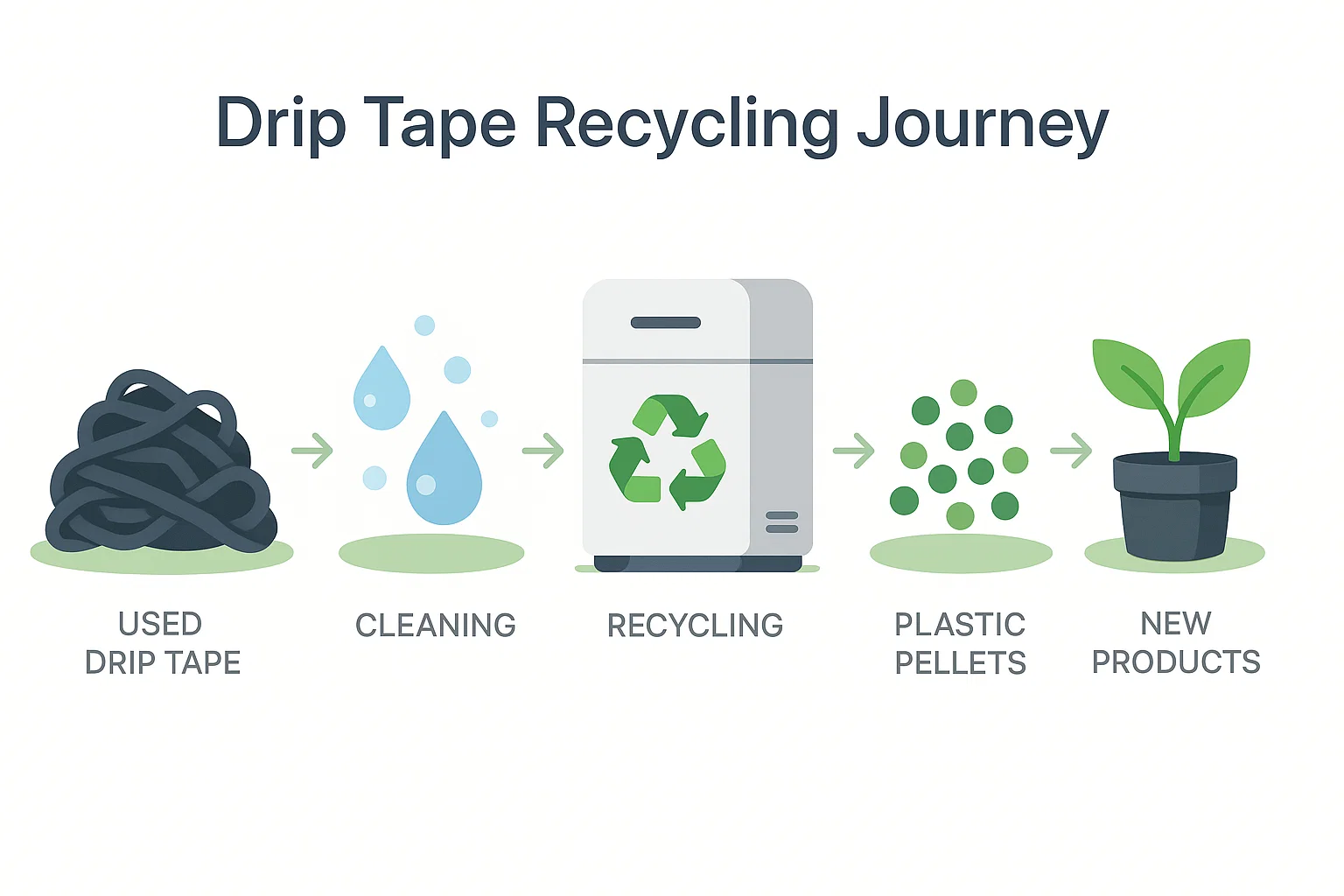현대 농업은 기후 변화의 영향부터 효율적인 자원 관리의 절실한 필요성까지 수많은 과제에 직면해 있습니다. 현대 농업의 초석은 드립 테이프 – 정밀 관개에 필수적인 도구입니다. 하지만 그 확실한 이점은 수명이 다한 후 관리해야 하는 책임과 함께 제공됩니다. 이 종합 가이드는 다음과 같은 내용을 다룹니다. 드립 테이프 재활용농업 폐기물을 어떻게 귀중한 자원으로 전환할 수 있는지 탐구하고, 농업의 보다 지속 가능한 미래를 위한 길을 마련합니다.
드립 테이프 이해: 농부의 필수 도구
일반적으로 저밀도 폴리에틸렌(LDPE) 또는 고밀도 폴리에틸렌(HDPE)으로 제조되는 드립 테이프는 농업 관개 시스템의 핵심 구성 요소입니다. 주요 기능은 물을 식물 뿌리에 직접 공급하는 것으로, 기존 관개 방식에 비해 물 사용량을 크게 줄이는 동시에 식물의 건강하고 왕성한 생장을 촉진합니다.
드립 테이프의 독창적인 디자인은 매우 효율적인 물 분배를 가능하게 합니다. 하지만 일단 그 목적을 달성하면, 대개 한 번의 재배 기간이 지나면, 상당한 양의 플라스틱 폐기물을 발생시킵니다. 플라스틱 오염과 관련된 환경적 우려는 이미 잘 알려져 있기 때문에, 드립 테이프 재활용 미래지향적이고 지속 가능한 농업을 위한 중요한 관행으로 떠올랐습니다.
드립 테이프는 어떻게 재활용될까요? 현장에서 신제품으로의 여정
그만큼 드립 테이프 재활용 사용된 관개 파이프를 재사용 가능한 플라스틱 펠릿으로 변환하는 특수 공정이 포함됩니다. RUMTOO의 고효율 원스텝 플라스틱 재활용 기계인 Repro-Flex와 같은 첨단 기계는 이 작업을 위해 특별히 설계되었습니다. 효과적인 플라스틱 펠릿 재활용을 위한 일반적인 단계, 이점 및 권장 사항을 살펴보겠습니다. 드립 테이프 재활용.
재활용 과정: 단계별
- 수집 및 전처리:
- 여행은 밭에서 사용된 드립 테이프를 모으는 것으로 시작됩니다.
- 가장 중요한 것은 흙, 식물 잔해, 기타 오염 물질을 제거하기 위해 철저히 세척하는 것입니다. 이 세척 단계는 최종 재활용 재료의 높은 품질을 보장하는 데 매우 중요합니다.
- 드립 테이프는 세척이 끝나면 미리 조정을 거치는데, 종종 더 작고 다루기 쉬운 조각으로 잘라 재활용 시스템에 버릴 준비를 합니다.
- 통합 절단 및 압축(커터-압축기 기술):
- RUMTOO Repro-Flex와 같은 최신 시스템에는 커터 콤팩터가 통합되어 있습니다. 이 혁신적인 설계 덕분에 별도의 독립형 사전 절단 또는 파쇄 단계가 필요 없는 경우가 많습니다.
- 이러한 통합으로 전체 운영이 간소화되어 효율성이 높아지고, 기계 설치 공간이 줄어들고, 에너지 소비도 줄어듭니다.
- 커터 압축기는 플라스틱 소재를 빠르게 잘라 압축하여 압출 단계에 최적으로 대비시킵니다.
- 압출 및 펠릿화:
- 사전 조절되고 압축된 재료는 계속해서 압출기에 공급됩니다.
- 압출기 내부에서 플라스틱은 가열되고 녹고 균질화됩니다.
- 용융된 플라스틱은 다이를 통과하여 균일한 펠릿으로 절단되는데, 일반적으로 고온 다이 페이스 펠릿타이저를 사용합니다. 이 단계는 일관되고 고품질의 재활용 펠릿을 생산하는 데 핵심적인 역할을 합니다.
- 최종 제품: 고품질 재활용 펠릿:
- 그 결과 만들어진 플라스틱 펠릿은 원래 재료의 바람직한 특성을 대부분 그대로 유지합니다.
- 이를 통해 플라스틱 폐기물을 새로운 생산 주기에 직접 통합할 수 있어, 플라스틱 폐기물에 대한 "루프를 닫고" 순환 경제를 옹호하는 데 효과적입니다.
- 이러한 재활용 펠릿은 새로운 드립 테이프나 다양한 다른 플라스틱 제품을 제조하는 데 사용될 수 있습니다.
고급 드립 테이프 재활용의 주요 이점(예: Repro-Flex 사용)
특히 Repro-Flex와 같은 첨단 장비를 사용한 드립 테이프 재활용은 수많은 이점을 제공하며, 지속 가능성을 중시하는 조직에 점점 더 매력적인 옵션이 되고 있습니다.
- 향상된 효율성 및 생산성: 통합 시스템은 기존의 다단계 재활용 시스템에 비해 생산량을 크게 늘릴 수 있습니다. 즉, 더 짧은 시간에 더 많은 폐기물을 처리할 수 있다는 의미입니다.
- 운영 비용 절감: 이러한 기계의 간소화된 특성으로 인해 단위 생산량당 에너지 소비와 노동 요구 사항이 줄어드는 경우가 많습니다.
- 공간 최적화: 여러 가지 공정(절단, 압축, 펠릿화 등)을 단일 장치로 결합함으로써 귀중한 공장 바닥 공간을 절약할 수 있습니다.
- 일관된 펠릿 품질: 첨단 온도 제어, 여과 및 펠릿화 기술을 통해 생산된 펠릿은 높은 재료 무결성을 유지합니다. 이러한 품질은 신제품에 성공적으로 적용하여 신뢰성과 성능을 보장하는 데 필수적입니다.
- 환경 관리: 아마도 가장 중요한 것은 효과적입니다 드립 테이프 재활용 매립이나 소각으로 버려지는 플라스틱의 양을 대폭 줄여 오염을 줄이고 천연자원을 보존합니다.
효과적인 드립 테이프 재활용을 위한 권장 장비
효율적이고 효과적인 작업을 위해서는 적절한 기계를 선택하는 것이 중요합니다. 드립 테이프 재활용고려해야 할 몇 가지 시스템 유형은 다음과 같습니다.
- 커터-컴팩터 통합 펠렛화 장치(예: Repro-Flex):
이 제품은 LDPE/HDPE 필름 및 테이프에 주로 사용됩니다. 통합 커터-컴팩터는 드립 테이프와 같은 가볍고 유연한 소재를 효율적으로 처리하며, 압출 직전에 사전 컨디셔닝합니다. 이러한 단일 단계 방식은 탁월한 효율성과 펠릿 품질을 제공합니다. - 2단계 재활용 기계:
이 기계는 오염 수준이 높을 수 있는 드립 테이프(초기 세척 후에도) 또는 인쇄 시 특히 유용합니다. 2단계 공정은 용융 및 초기 여과/탈기 작업을 위한 1차 압출기와, 추가 정제 및 펠렛화를 위한 2차 압출기로 구성됩니다. 이를 통해 더 까다로운 투입물에서도 우수한 펠렛 품질을 얻을 수 있습니다. - 분쇄기 통합 플라스틱 재활용 기계:
특히 부피가 크거나 질긴 농업용 플라스틱의 경우, 또는 드립 테이프가 다른 더 단단한 재료와 혼합되는 경우, 압출기 앞에 고성능 분쇄기가 통합된 시스템이 적합할 수 있습니다. 분쇄기는 초기 크기 감소를 제공하여 압출기가 재료를 더 쉽게 처리할 수 있도록 합니다.
드립 테이프 재활용: 농업 분야를 넘어선 응용 분야
물론 사용된 드립 테이프의 주요 공급원은 농업이지만, 생산된 재활용 펠릿은 놀라울 정도로 다재다능합니다. 다양한 산업으로 확장되어 경제적, 환경적 가치를 높일 수 있습니다. 드립 테이프 재활용 노력:
- 새로운 농업용 플라스틱: 가장 직접적인 방법은 새로운 드립 테이프나 다른 농업용 필름을 만드는 것입니다.
- 플라스틱 봉지 및 포장재: 재활용 LDPE와 HDPE는 일반적으로 새로운 운반용 가방, 쓰레기 봉투, 다양한 유형의 유연 포장재를 제조하는 데 사용되어, 원래 플라스틱에 대한 의존도를 줄입니다.
- 건축 자재: 고품질 재활용 플라스틱 펠릿은 플라스틱 목재, 파이프 또는 배수 시스템 구성품과 같은 제품에 통합되어 보다 친환경적인 건축 관행에 기여할 수 있습니다.
- 소비재: 야외 가구와 화분부터 장난감과 보관 용기까지 다양한 일상 용품을 재활용 플라스틱을 사용해 제조할 수 있어 소비자 시장의 지속 가능성이 향상됩니다.
FAQ: 드립 테이프 재활용에 대한 질문에 대한 답변
Q1: 드립 테이프는 실제로 무엇으로 만들어졌나요?
답변: 드립 테이프는 일반적으로 저밀도 폴리에틸렌(LDPE)이나 고밀도 폴리에틸렌(HDPE)과 같은 플라스틱으로 제조되며, 유연성, 내구성, 비용 효율성이 뛰어난 소재로 선택됩니다.
Q2: 모든 드립 테이프를 재활용할 수 있나요?
A: 네, 대부분의 LDPE 및 HDPE 드립 테이프는 RUMTOO Repro-Flex와 같은 특수 기계를 사용하여 효과적으로 재활용할 수 있습니다. 이 기계는 드립 테이프를 재사용 가능한 플라스틱 펠릿으로 만들어 줍니다. 중요한 것은 적절한 세척과 수거입니다.
Q3: 드립 테이프 재활용이 왜 그렇게 중요한가요?
답변: 드립 테이프를 재활용하는 것은 농업에서 플라스틱 폐기물을 크게 줄이고 귀중한 천연자원(신형 플라스틱을 만드는 데 사용되는 석유와 가스)을 보존하고 매립지 부담을 줄이며 순환 경제를 촉진하여 전반적인 지속 가능성에 기여하기 때문에 매우 중요합니다.
Q4: 드립 테이프 재활용에 가장 적합한 기계는 무엇입니까?
A: 커터-압축기 통합 펠렛화기(예: RUMTOO Repro-Flex), 2단계 재활용 기계(더 오염된 재료용) 및 분쇄기 통합 재활용 기계와 같은 기계는 모두 효율적인 작업에 적합합니다. 드립 테이프 재활용테이프의 구체적인 상태와 볼륨에 따라 달라집니다.
Q5: Repro-Flex와 같은 기계는 드립 테이프 재활용 과정을 어떻게 개선합니까?
A: Repro-Flex 및 유사한 커터-컴팩터 통합 시스템은 재료 절단, 압축, 압출, 펠릿화를 하나의 효율적인 장치로 통합하여 공정을 간소화합니다. 이를 통해 기존의 다단계 시스템에 비해 생산량이 증가하고 펠릿 품질이 향상되며, 공간 및 에너지 요구량이 감소합니다.
Q6: 재활용된 드립 테이프 펠릿은 무엇에 사용할 수 있나요?
A: 재활용 드립 테이프 펠릿은 다재다능합니다. 새로운 드립 테이프, 다양한 비닐봉지 및 포장재, 건설 산업용 부품, 그리고 다양한 소비재 생산에 사용될 수 있습니다.
결론: 드립 테이프 재활용으로 더 푸른 미래를 맞이하다
진정으로 지속 가능한 농업을 향한 우리의 집단적 여정에서, 드립 테이프 재활용 실용적이고 효과적인 사례로 손꼽힙니다. 사용된 관개 자재를 폐기물에서 고품질 플라스틱 펠릿으로 전환함으로써 플라스틱 오염을 줄이고 귀중한 자원을 보존하는 데 큰 진전을 이룰 수 있습니다. RUMTOO Repro-Flex와 같은 첨단 재활용 장비를 활용하면 이 과정이 환경적으로 건전할 뿐만 아니라 효율적이고 경제적으로 실행 가능해집니다.
미래 지향적인 농부, 농업 협동조합 및 재활용 조직의 경우 투자 드립 테이프 재활용 지속가능성 목표와 완벽하게 부합하는 동시에 폐기물을 가치 있는 자원으로 전환하여 실질적인 경제적 이익을 제공합니다. 드립 테이프 재활용 그리고 더 건강한 지구와 보다 순환적이고 지속 가능한 세상을 만드는 데 함께 기여합니다.



